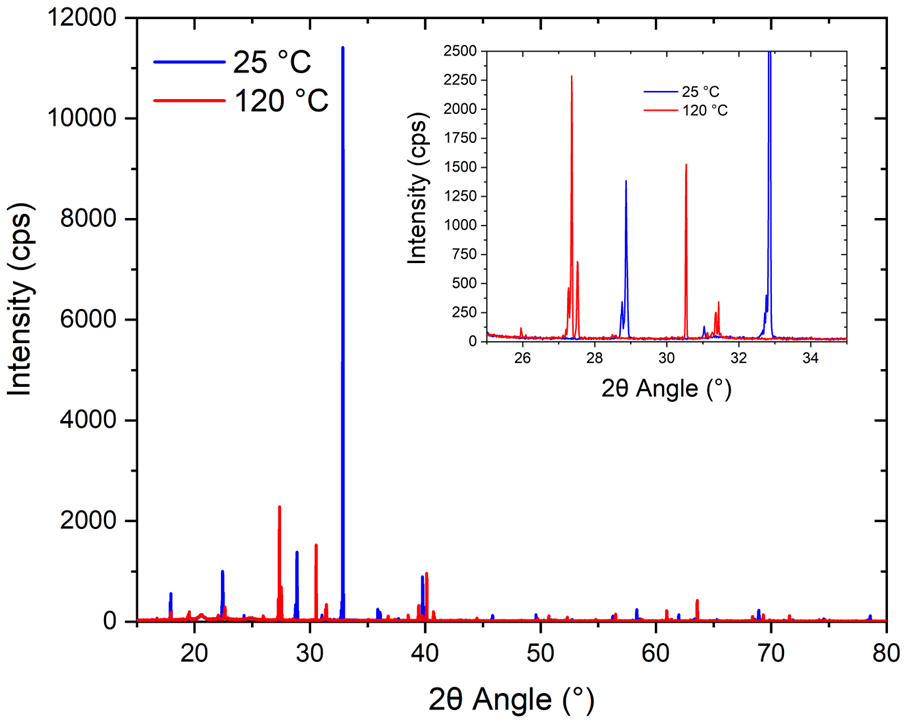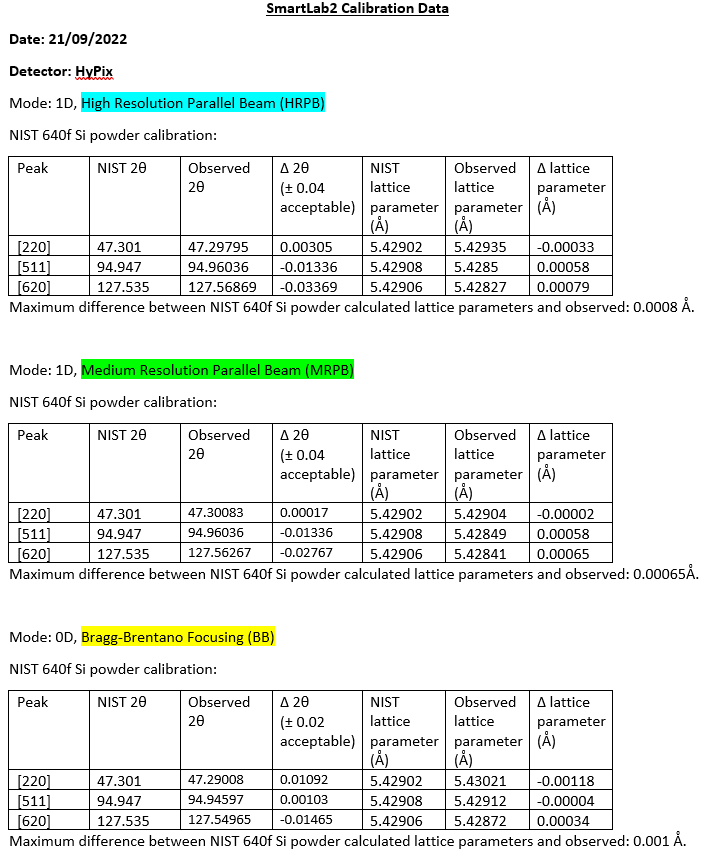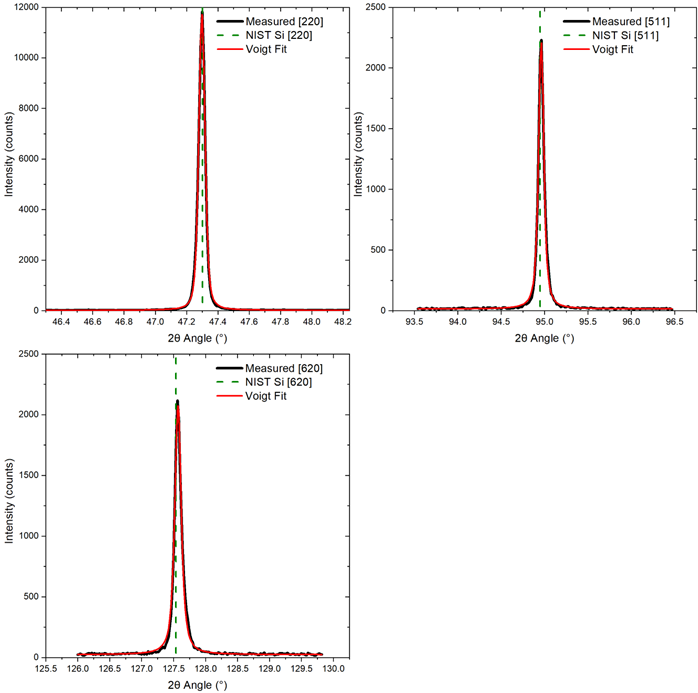The Materials Characterisation Laboratory has had a couple of students this year whose work is highlighted below, has upgraded some equipment, and has improved its calibration techniques.
Contents:
Christmas/New Year Closure Periods
The lab will be closed from 16/12/22 for Christmas, and will undergo a month of lab start-up in January until 31/01/23, with the lab available again from 02/02/23. Please
contact the MCL Lab for more details. The booking calendar is up to date, so if you will need time in the New Year, please feel free to
book now.
New Equipment
Over the course of the last 6 months, work has been undertaken to install and commission new options for existing instruments to expand their capabilities and support more varied measurements from the user programme.
New PPMS Option: AC Dilution Fridge
The new Physical Properties Measurement System (PPMS) option, an Alternating Current Dilution Refrigerator (ACDR) has been installed and tested on the Dynacool system.

The ACDR is loaded upside down (left) and installed into the Dynacool PPMS system (right).
The below graph shows the first successful run of a user measurement utilizing AC susceptibility at dilution fridge temperatures. It shows the real and imaginary components of the susceptibility as a function of temperature and applied frequency which shows the spin glass behaviour.

AC susceptibility of Ho2Ti2O7, produced by Thomas Hicken, reproduced with permission.
The sample is Ho2Ti2O7. The measurement was taken between 0.05 K and 4 K. The AC magnetic field excitation was at a selected frequency 10 Hz – 10 kHz and amplitude up to 4 Oe.
The ACDR is now available for user
bookings on IdeaElan. Please
contact the MCL for more details.
New SmartLab2 Heater Stage: DHS1100

DHS1100 during measurement with PEEK dome (left) and during powder sample loading (right)
A new heater option for the thin film diffraction instrument, SmartLab2, has been installed. This Domed Holder Stage (DHS1100) is capable of sustaining temperatures up to 1100 °C. While primarily for thin film samples, we do also have the option to measure powder diffraction samples on this stage.
Initial calibrations with the instrument have been undertaken, checking the phase transition temperatures of known materials. The graphs below are at two temperatures of an ammonium nitrate sample, with an obvious phase transition between them. It was measured with a PEEK dome. For higher temperatures, a Carbon Fibre dome is also available, or if the maximum temperature is <200
°C it is even possible to measure without a dome present, opening up more measurement possibilities!

Ammonium nitrate (NH4NO3) sample at different temperatures, showing a clear phase transition.
Measurements can be performed under vacuum. Because of the stage used, it is possible to rotate the sample under heating conditions, or even to modify the chi angle (for non-powder samples) until the sample is vertical, allowing for pole figures and reciprocal space mapping with respect to temperature. If measuring with respect to chi, please do remember to secure your sample to the stage as friction alone is unlikely to be sufficient.
This stage is available to be
booked through IdeaElan. For further information, please
contact the MCL.
Summer Student: Hannah Cole, investigation into the use of the single crystal diffractometer to measure powder samples.
Over the summer, the MCL welcomed Hannah Cole, a student from Oxford, to the lab. Her 10 week project was to look at the viability of using the single crystal instrument to record powder diffraction data of high enough quality to be of use, then to optimise these measurements. Hannah found that it was possible to carry out powder diffraction measurements on the single crystal diffractometer.

Mounting methods for powder samples measured on the SX-XRD. Capillary loading (left) and sample loop loading (right)
This could be done with either a capillary-mounted powder sample, or a few micrograms of powder loaded onto a sample loop, as a single crystal would be, allowing for powder measurements of very small amounts of powder compared with our standard powder diffractometers.
Hannah spent time optimising the conditions needed for the best measurement, running through all of the available parameters to vary, and found that the most significant factor by far was the beam divergence, a capability we have on our copper source, allowing for higher quality data to be obtained.

Comparison of the same sample measured with different modes.
Hannah investigated the different modes of operation for powder diffraction measurements. All three measurements above were taken with the exact same sample and mounting; Hannah found that using the 'Gandolfi move' mode offered the best improvement for samples with larger crystallites, but due to the extra freedom of movement required for this mode it is best applied to samples mounted on a pin rather than a capillary.

A first attempt at measuring variable temperature powder diffraction on the SX-XRD.
Hannah also investigated the use of the measurements at low temperature, which show promising results, some of which can be seen above. Further optimisation is needed, but it looks promising so far.
For more information about the possibility of measuring powder samples with the single crystal diffractometer, please
contact the MCL staff.
So, where are you from, what’s your educational background?
I grew up near Liverpool, well, technically the Wirral, but no one seems to know what a Wirral is, but now I study in Belfast. Before I started my course, I sort of saw Belfast as a temporary place to be while I got my degree, but now I really do consider it my home; when people ask me where I’m from I say Belfast, which is always a good sign that I’ve found a new home! I study BSc Physics as of now, but I might switch to the master’s program after this year, we’ll see how it goes! Right now, I’m on this placement instead of third year.
Why did you decide to do Physics?
Honestly, I’ve always been interested in how things work and why things are the way they are. As a – this is so cliché – as a kid I’d always ask my Mum ‘Why, why!?’ but it didn’t take long for me to start asking questions she didn’t know the answer to. That, and both my parents encouraged my interest in the sciences… 1) because it’s good to be curious and 2) because STEM is a ‘lucrative, buildable career’, at least in theory!
I’m doing a physics degree because it was inevitable, but also because I do genuinely enjoy science.
The reason I chose this placement is to see if I can put my money where my mouth is and see if I enjoy research enough to consider it as a career.
What are you currently working on, what’s your project?
My official placement title is 'materials characterisation method developer', which is exactly what it says on the tin! I've worked with a range of different instruments and experiments like how to perform x-ray reflectivity measurements, use an atomic force microscope, a physical properties measurement system, MOKE, the list goes on!
The ultimate end goal of my project is to optimise a method for performing ferromagnetic resonance experiments in such a way that the data collected can be used on the POLREF beamline. The previous student did work on a few different areas of FMR but I’m focussing on doing FMR with polarised neutron reflectometry. I’ve recently designed a more secure way of holding the coplanar waveguide in the FMR experiment. It’s very exciting to see how changing certain parameters affects my results, it’s so different from university coursework where you know what to expect, here it really feels like I’m doing something new! I’m also working on how to streamline normal FMR so that it only takes less than a minute to determine the conditions under which resonance occurs in a sample, rather than a few hours, which can be done by improving the current LabVIEW code and writing some separate programs.
How’s it going? Dangerous question, I know!
The x-ray reflectivity part of the project is going well! I’ve been asked to order equipment, do some data analysis, and design some pieces of specialised lab equipment, but I already have a little bit of CAD experience, so when I handed over the schematic for my first design, I was complimented three times by three people on how ‘this is more than I was expecting,’ so, so far that’s worked out!
I really enjoy using the actual lab equipment, there was a very steep learning curve at the start but now I’m in the swing of things and interacting with other departments and businesses to get stuff ordered in; I really feel like part of the team. It’s kind of crazy when I think back to the start of this placement and compare my knowledge then to what I know now? Just makes me more eager to get a wiggle on with what I’m doing and see how far I can push myself!
The ferromagnetic resonance part is going well too, I’m making steady progress with coding in LabVIEW, getting the instruments to communicate with each other and stuff proved a lot more difficult than I was expecting but I managed to get the basics working, now I get to move onto more challenging tasks, which is really exciting!
Outside of work, what do you like to do?
I do really like exploring Oxford. I’ve been a few times with my friends, but I’ve never got to explore it of my own accord, and now I can do that with a train pass as well. It’s great, I can do whatever I want! In my school years I dedicated a lot of time to extra-curricular activities, never really had a lot of time to myself, so right now I’m just taking full advantage of having a work-life balance, because I didn’t manage my time in university very well, and just enjoying my time appreciating the smaller things. I brought my guitar from home with me, maybe I’ll start playing that more often, even though I’ve been teaching myself for a few years now I’d still never tell an actual guitarist that I play! It would be nice to have something to show for those years.
Calibration Reports
To ensure confidence in our instruments can be maintained at an exceptionally high level, MCL staff regularly calibrate and test the instruments in the MCL. As was discussed in the previous issue of the newsletter, the MCL team are continuously improving the methodology of these calibrations to ensure that they are as in-depth as possible, going beyond even the manufacturer's installation specifications/recommended calibrations by using standards (e.g. NIST standards) to calibrate known measurements, using this information to construct reports to make these calibrations easily accessible to users.
I plan to highlight these calibrations in these newsletters, starting with the SmartLab x-ray diffraction systems.

Quick view of the report, showing that the calculated parameters vs NIST standard parameters.
For the SmartLab powder x-ray diffractometer, the manufacturer provides details for the acceptable angles for the Bragg-Brentano Focusing mode to calibrate against, but not for the Parallel Beam optics modes. For these, there is a calibration for the monochromator using a thin film, but no powder diffraction. Using a NIST silicon sample, we have added calibrations for both of the Parallel Beam optical modes. This has allowed us to notice small changes in the instrument long before they would become apparent in user data and nip potential problems in the bud.

Measurements in High Resolution Parallel Beam optics mode, showing the expected positions along with the fit of the data.
By using the same fitting method for each set of measurements, it becomes rapidly apparent if the peaks shift. These are currently fit in Origin, the lattice parameters then calculated from the fitted peak positions.
Work is ongoing to create similarly in-depth reports for all MCL instruments, and to update the existing reports to include calibrations for more modes and options. One of the currently ongoing projects is to use standards to confirm the temperatures in non-ambient stages. We are constantly refining our methodology to improve confidence in our instruments.
For any further details about the Materials Characterisation Lab or anything included on this page, please
contact the MCL Lab Manager, Dr Gavin Stenning and check out the Materials Characterisation Lab
website.
